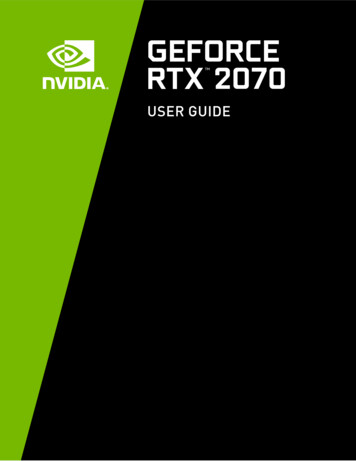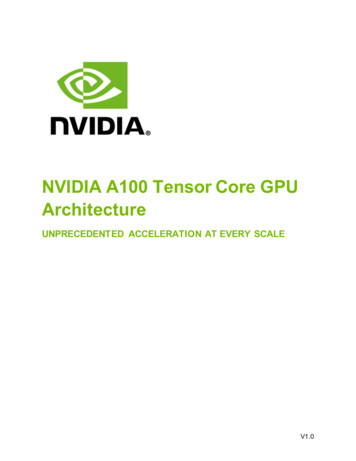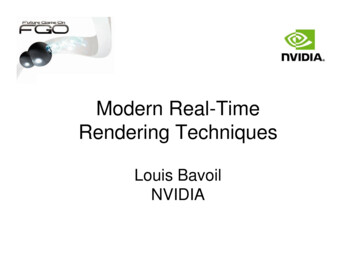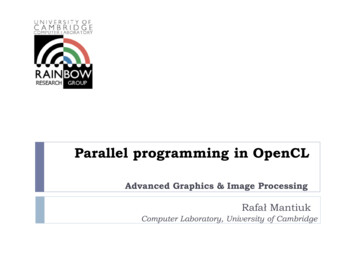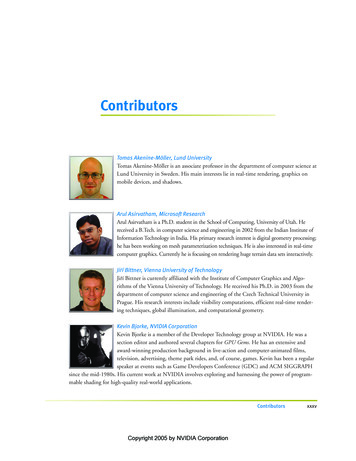
Transcription
ContributorsTomas Akenine-Möller, Lund UniversityTomas Akenine-Möller is an associate professor in the department of computer science atLund University in Sweden. His main interests lie in real-time rendering, graphics onmobile devices, and shadows.Arul Asirvatham, Microsoft ResearchArul Asirvatham is a Ph.D. student in the School of Computing, University of Utah. Hereceived a B.Tech. in computer science and engineering in 2002 from the Indian Institute ofInformation Technology in India. His primary research interest is digital geometry processing;he has been working on mesh parameterization techniques. He is also interested in real-timecomputer graphics. Currently he is focusing on rendering huge terrain data sets interactively. Jirí Bittner, Vienna University of TechnologyJirí Bittner is currently affiliated with the Institute of Computer Graphics and Algorithms of the Vienna University of Technology. He received his Ph.D. in 2003 from thedepartment of computer science and engineering of the Czech Technical University inPrague. His research interests include visibility computations, efficient real-time rendering techniques, global illumination, and computational geometry.Kevin Bjorke, NVIDIA CorporationKevin Bjorke is a member of the Developer Technology group at NVIDIA. He was asection editor and authored several chapters for GPU Gems. He has an extensive andaward-winning production background in live-action and computer-animated films,television, advertising, theme park rides, and, of course, games. Kevin has been a regularspeaker at events such as Game Developers Conference (GDC) and ACM SIGGRAPHsince the mid-1980s. His current work at NVIDIA involves exploring and harnessing the power of programmable shading for high-quality real-world applications.ContributorsCopyright 2005 by NVIDIA Corporationxxxv
Ian Buck, Stanford UniversityIan Buck is completing his Ph.D. in computer science at the Stanford Computer Graphics Lab, researching general-purpose computing models for GPUs. He received a B.S.E.in computer science from Princeton University in 1999 and received fellowships fromthe Stanford School of Engineering and NVIDIA. His research focuses on programminglanguage design for graphics hardware as well as general-computing applications thatmap to graphics hardware architectures.Michael Bunnell, NVIDIA CorporationMichael Bunnell graduated from Southern Methodist University with degrees in computerscience and electrical engineering. He wrote the Megamax C compiler for the Macintosh,Atari ST, and Apple IIGS before cofounding what is now LynuxWorks. After working onreal-time operating systems for nine years, he moved to Silicon Graphics, focusing on imageprocessing, video, and graphics software. Next, he worked at Gigapixel, then at 3dfx, andnow at NVIDIA, where, interestingly enough, he is working on compilers again—this time, shader compilers.Iain Cantlay, Climax EntertainmentIain Cantlay is currently a senior engineer at Climax, where he was responsible for thegraphical aspects of the Leviathan MMO engine and Warhammer Online. His current projects include MotoGP 3 (to be published for Xbox and PC by THQ in 2005). Iain is passionate about exploiting the best visuals from the latest technology, but natural phenomenainterest him most: terrain, skies, clouds, vegetation, and water.Francesco Carucci, Lionhead StudiosFrancesco Carucci graduated from the Politecnico di Torino in Italy with a degree in software engineering. When he was eight, rather than make pizza (like every good Italian), hedecided to make video games, and he tried to animate a running character in BASIC on anIntellivision. He is now writing code to animate running characters at Lionhead, workingon the latest rendering technology for Black & White 2. He contributed to various Italiantechnical 3D sites and to ShaderX2. His main interests include lighting and shadowing algorithms, 3D softwareconstruction, and the latest 3D hardware architectures. And when he needs help, he writes shaders for food.Cem Cebenoyan, NVIDIA CorporationCem Cebenoyan is a software engineer working in the Developer Technology group atNVIDIA. He was an author and section editor for GPU Gems. He spends his days researching graphics techniques and helping game developers get the most out of graphics hardware.He has spoken at past Game Developer Conferences on character animation, graphics performance, and nonphotorealistic rendering. Before joining NVIDIA, he was a student andresearch assistant in the Graphics, Visualization, and Usability Lab at the Georgia Institute of Technology.xxxviContributorsCopyright 2005 by NVIDIA Corporation
Eric Chan, Massachusetts Institute of TechnologyEric Chan is a Ph.D. student in the Computer Science and Artificial Intelligence Laboratory at M.I.T. He fiddles with graphics architectures, shading languages, and real-timerendering algorithms. He has recently developed efficient methods for rendering hardand soft shadows. Before attending graduate school, Eric was a research staff member inthe Stanford Computer Graphics Laboratory. As part of the Real-Time ProgrammableShading team, he wrote compiler back ends for the NV30 and R300 fragment architectures and developed apass-decomposition algorithm for virtualizing hardware resources. Eric enjoys photography and spends anunreasonable amount of his free time behind the camera.Greg Coombe, The University of North Carolina at Chapel HillGreg Coombe is a graduate student at the University of North Carolina at Chapel Hill.He received a B.S. in mathematics and a B.S. in computer science from the University ofUtah in 2000. Greg’s research interests include global illumination, graphics hardware,nonphotorealistic rendering, virtual environments, and 3D modeling. During the courseof his graduate studies, he has worked briefly at Intel, NVIDIA, and Vicious Cycle Software. Greg was the recipient of the NVIDIA Graduate Fellowship in 2003 and 2004.Jürgen Döllner, University of Potsdam, Hasso-Plattner-InstituteJürgen Döllner, a professor at the Hasso-Plattner-Institute of the University of Potsdam,directs the computer graphics and visualization division. He has studied mathematicsand computer science and received a Ph.D. in computer science. He researches andteaches in real-time computer graphics and spatial visualization.William Donnelly, NVIDIA Corporation and University of WaterlooWilliam Donnelly is a fourth-year undergraduate in computer science and mathematics atthe University of Waterloo in Ontario. He interned with Okino Computer Graphics, wherehe worked on global illumination and volumetric rendering; and with NVIDIA’s DemoTeam, where he worked on the “Last Chance Gas” and “Nalu” demos. He has been destinedfor greatness in computer graphics since mastering the art of the Bezier spline at age ten.Frédo Durand, Massachusetts Institute of TechnologyFrédo Durand received a Ph.D. from Grenoble University in France in 1999, where he workedon both theoretical and practical aspects of 3D visibility. From 1999 until 2002, he was apostdoc in the M.I.T. Computer Graphics Group, where he is now an assistant professor. Hisresearch interests span most aspects of picture generation and creation, including realisticgraphics, real-time rendering, nonphotorealistic rendering, and computational photography.He received a Eurographics Young Researcher Award in 2004. (Digital drawing courtesy of Victor Ostromoukhov)ContributorsCopyright 2005 by NVIDIA Corporationxxxvii
Eric Enderton, NVIDIA CorporationEric Enderton is a senior engineer at NVIDIA, where he is working on the Gelato filmrenderer. After studying computer science at the University of California, Berkeley, Ericspent a decade developing rendering and animation software at Industrial Light &Magic, and he later consulted at other studios. His film credits include Terminator 2;Jurassic Park; and Star Wars, Episode I: The Phantom Menace.Zhe Fan, Stony Brook UniversityZhe Fan is a Ph.D. candidate in the computer science department at Stony Brook University. He received a B.S. in computer science from the University of Science and Technologyof China in 1998 and an M.S. in computer science from the Chinese Academy of Sciencesin 2001. His current research interests include GPU clusters for general-purpose computation, parallel graphics and visualization, and modeling of amorphous phenomena.Randima Fernando, NVIDIA CorporationRandima (Randy) Fernando has loved computer graphics since age eight. Working inNVIDIA’s Developer Technology group, he helps teach developers how to take advantageof the latest GPU technology. Randy has a B.S. in computer science and an M.S. in computer graphics, both from Cornell University. He has published research in SIGGRAPHand is coauthor, with Mark Kilgard, of The Cg Tutorial: The Definitive Guide to Programmable Real-Time Graphics. He edited GPU Gems: Programming Techniques, Tips, and Tricks for Real-Time Graphicsand is the GPU Gems series editor.Nathaniel Fout, University of California, DavisNathaniel Fout received a B.S. in chemical engineering and an M.S. in computer sciencefrom the University of Tennessee in 2002 and 2003, respectively. He is a Ph.D. student incomputer science at the University of California, Davis, where he is a member of the Institute for Data Analysis and Visualization. His research interests include volumetric compression for rendering, multivariate and comparative visualization, and tensor visualization.James Fung, University of TorontoJames Fung is completing his Ph.D. in engineering. He received a B.A.Sc. in engineeringscience and an M.S. in electrical engineering from the University of Toronto. His research interests include wearable computing, mediated reality, and exploring new typesof musical instrument interfaces based on EEG brain-wave signal processing. His mostrecent work has been the development of the GPU-based computer vision and mediatedreality library called OpenVIDIA.xxxviiiContributorsCopyright 2005 by NVIDIA Corporation
Simon Green, NVIDIA CorporationSimon Green is a senior software engineer in the Developer Technology group atNVIDIA. He started graphics programming on the Sinclair ZX-81, which had 1 kB ofRAM and a screen resolution of 64 q 48 pixels. He holds a B.S. in computer science fromthe University of Reading, in the United Kingdom, in 1994. Since 1999 Simon hasfound a stable home at NVIDIA, where he develops new rendering techniques and helpsapplication developers take maximum advantage of GPU hardware. He is a frequent presenter at GDC, haswritten for Amiga Shopper and Wired magazines, and was a section editor for GPU Gems. His research interestsinclude cellular automata, general-purpose computation on GPUs, and analog synthesizers.Toshiya Hachisuka, University of TokyoToshiya Hachisuka is an undergraduate in the Department of Systems Innovation at theUniversity of Tokyo. He also works as a programmer for MagicPictures, integrating cuttingedge research results into current computer graphics software. He has studied computergraphics since age ten. His current research interests are physically based rendering, physicallybased modeling, real-time rendering techniques, and general-purpose computation on GPUs.Markus Hadwiger, VRVis Research CenterMarkus Hadwiger received his Ph.D. in computer science from the Vienna University ofTechnology in 2004, where he concentrated on high-quality real-time volume rendering andtexture filtering with graphics hardware, in cooperation with the VRVis Research Center. Hehas been a researcher at VRVis since 2000, working in the Basic Research on Visualizationgroup and the Medical Visualization group (since 2004). From 1996 to 2001, he was alsothe lead programmer of the cross-platform 3D space-shooter game Parsec, which is now an open source project.Mark Harris, NVIDIA CorporationMark Harris received a B.S. from the University of Notre Dame in 1998 and a Ph.D. incomputer science from the University of North Carolina at Chapel Hill (UNC) in 2003.At UNC, Mark’s research covered a wide variety of computer graphics topics, includingreal-time cloud simulation and rendering, general-purpose computation on GPUs, globalillumination, nonphotorealistic rendering, and virtual environments. Mark is now amember of NVIDIA’s Developer Technology team based in the United Kingdom.Jon Hasselgren, Lund UniversityJon Hasselgren received an M.Sc. from Lund University. He now pursues graduate studies in the computer science department, where he researches graphics for mobile phones.ContributorsCopyright 2005 by NVIDIA Corporationxxxix
Oliver Hoeller, Piranha BytesOliver Hoeller is a senior software engineer at Piranha Bytes, which developed the RPGsGothic I and Gothic II. Previously he was director of development at H2Labs/Codecult,where he was responsible for development and architecture design of the Codecreaturesgame system. He was an active member of the German demo scene in the 1980s andearly 1990s. After exploring different areas—developing music software, creating a security program, and working as a Web services consultant—Oliver returned to his roots and now guarantees ahigh level of visual quality for Piranha Bytes’forthcoming Gothic III.Hugues Hoppe, Microsoft ResearchHugues Hoppe is a senior researcher in the Computer Graphics Group at MicrosoftResearch. His primary interests lie in the acquisition, representation, and rendering ofgeometric models. He received the 2004ACM SIGGRAPH Achievement Award for hispioneering work on surface reconstruction, progressive meshes, geometry texturing, andgeometry images. His publications include twenty papers at ACM SIGGRAPH, and heis associate editor of ACM Transactions on Graphics. He received a B.S. in electrical engineering in 1989 and aPh.D. in computer science in 1994from the University of Washington.Daniel Horn, Stanford UniversityDaniel Horn is a Ph.D. candidate at the Stanford Computer Graphics Lab; he receivedhis B.S. from the University of California, Berkeley. While Daniel focuses on programming graphics hardware and real-time graphics, theory and compilers have always interested him deeply, and he tries to incorporate knowledge from those fields into hisgraphics research. In his spare time, Daniel enjoys hacking with his brother, Patrick, ontheir open source space sim, Vega Strike. He also enjoys roaming with friends in the Bay Area’s many naturalparks, from Palo Alto’s Foothills Park to Berkeley’s Tilden Park.Samuel Hornus, GRAVIR/IMAG–INRIASamuel Hornus is a Ph.D. candidate at INRIA in Grenoble, France. He is a formerstudent of the Ecole Normale Supérieure de Cachan. His research focuses on 3D visibility problems, as well as other aspects of computer graphics, such as texture authoring,interactive walkthroughs, real-time shadows, realistic rendering, implicit surfaces, andimage-based modeling.xlContributorsCopyright 2005 by NVIDIA Corporation
Arie Kaufman, Stony Brook UniversityArie Kaufman is the director of the Center for Visual Computing, a distinguished professor and chair of the Computer Science Department, and distinguished professor of radiology at Stony Brook University. He received a B.S. in mathematics and physics from theHebrew University of Jerusalem in 1969; an M.S. in computer science from the Weizmann Institute of Science, Rehovot, Israel, in 1973; and a Ph.D. in computer sciencefrom the Ben-Gurion University, Israel, in 1977. Kaufman has conducted research and consulted for morethan thirty years, with numerous publications in volume visualization; graphics architectures, algorithms, andlanguages; virtual reality; user interfaces; and multimedia.Jan Kautz, Massachusetts Institute of TechnologyJan Kautz is a postdoctoral researcher at M.I.T. He is particularly interested in realistic shading and lighting, hardware-accelerated rendering, textures and reflection properties, andinteractive computer graphics. He received his Ph.D. in computer science from the MaxPlanck-Institut für Informatik in Germany; a diploma in computer science from the University of Erlangen in Germany; and an M.Math. from the University of Waterloo in Ontario.Emmett Kilgariff, NVIDIA CorporationEmmett Kilgariff is a director of architecture in the GPU group at NVIDIA, where hehas contributed to the design of many GeForce chips, including the GeForce 6 andGeForce 7 Series. He has more than twenty years of experience designing graphics hardware, at Sun Microsystems, Silicon Graphics, 3dfx, and many small companies whosememories have faded over time.Gary King, NVIDIA CorporationUnscrupulous. Unconventional. Uncouth. Unkempt. All are accurate adjectives for theworst thing to happen to the graphics industry since Execute Buffers. A master of GPUarcana, lore, and the occult, he spends his days at NVIDIA crafting increasingly ingeniously nefarious rendering techniques, imbuing next-generation architectures with unholy energies, worshipping the Dark Lord, and kicking puppies.Peter Kipfer, Technische Universität MünchenPeter Kipfer is a postdoctoral researcher in the Computer Graphics and VisualizationGroup at the Technische Universität München. He received his Ph.D. from the University of Erlangen-Nürnberg in 2003 for his work on parallel and distributed visualizationand rendering within the KONWIHR supercomputing project. His current researchfocuses on general-purpose computing and geometry processing on the GPU.ContributorsCopyright 2005 by NVIDIA Corporationxli
Joe Kniss, University of UtahJoe Kniss is a Ph.D. student in computer science at the University of Utah, where he is amember of the Scientific Computing and Imaging Institute. His research interests includenonpolygonal rendering, light transport in participating media, user-interface design, andall things GPU. He is a Department of Energy High-Performance Computer Sciencegraduate fellow.Craig Kolb, NVIDIA CorporationCraig Kolb has been interested in computer graphics since he began writing games on his highschool’s sub-megaflop PDP-11. He received a B.A. and an M.Sc. from Princeton, where hewrote the first version of rayshade, a popular ray tracer, as part of his senior thesis. He spent the1990s waiting for frames to render: first as a research assistant to Benoit Mandelbrot at Yale,then as a Ph.D. candidate researching camera and rendering systems at Princeton and Stanford,and later as head of rendering development at Pixar Animation Studios. In 2000 he cofounded Exluna and nowworks in the Software Architecture group at NVIDIA finding novel ways to push multi-gigaflop GPUs to their limits.Jens Krüger, Technische Universität MünchenJens Krüger is a Ph.D. student in the Computer Graphics and Visualization Group at theTechnische Universität München. Jens’s current research focuses on GPU solutions to numerical problems, often arising in physically based simulations. He has published papers onGPU programming at conferences such as ACM SIGGRAPH and IEEE Visualization. In2004 he received an ATI Fellowship, which honors outstanding graduate students in areasrelated to computer graphics and graphics systems.Yuri Kryachko, 1C:Maddox GamesYuri Kryachko is the 3D graphics and effects programmer on IL-2 Sturmovik, WW2, IL-2Sturmovik: Forgotten Battles, AEP, and Pacific Fighters. He has been at Maddox Games since1996, and he’s been playing and creating PC games since writing his first 2D game in1987. He received an M.S. from the department of applied mathematics of the MoscowState Engineering Physics Institute (Technical University). Previous game projects includeCity3D–Drive Simulator (ELF) in 1995 and Helicopter Simulator from 1995 to 1996.Sylvain Lefebvre, GRAVIR/IMAG–INRIASylvain Lefebvre is a final-year Ph.D. student at INRIA in Grenoble, France. He receivedan M.S. in computer science from the INPG University, Grenoble, in 2001. His researchfocuses on developing new texturing methods for creating, storing, and rendering highlydetailed textures for real-time applications. Recently he has worked on landscape texturing, direct painting on meshes, and the progressive loading of texture maps. He is alsointerested in many aspects of game programming.xliiContributorsCopyright 2005 by NVIDIA Corporation
Aaron Lefohn, University of California, DavisAaron Lefohn is a Ph.D. student in the computer science department at the Universityof California, Davis, and a graphics software engineer at Pixar Animation Studios. Hiscurrent research focuses on data-parallel data structures and programming models andtheir application to high-quality interactive rendering. Aaron completed his M.S. incomputer science at the University of Utah in 2003; he received an M.S. in theoreticalchemistry from the University of Utah in 2001 and a B.A. in chemistry from Whitman College in 1997.Aaron is a National Science Foundation graduate fellow in computer science.Martin-Karl Lefrançois, mental imagesMartin-Karl Lefrançois is senior graphics software engineer at mental images in Berlin,maker of the mental ray renderer and other graphics software products. Under his lead,his team at mental images delivered automatic GPU support in mental ray 3.3 and isresponsible for GPU acceleration support in all mental images products. After graduatingwith a degree in computer science and mathematics from the University of Sherbrooke inQuebec, he worked as a graphics developer for nearly ten years at Softimage in Montreal and Tokyo beforeleading the core game engine team at A2M.Wei Li, Siemens Corporate ResearchWei Li is a research scientist at Siemens Corporate Research in Princeton, New Jersey. Hiscurrent research focuses on texture-based volume rendering and general-purpose computation on the GPU. He received an M.S. and a Ph.D. in computer science from Stony BrookUniversity in 2001 and 2004, respectively. He also received a B.S. and an M.S. in electricalengineering from Xi’an Jiaotong University in China in 1992 and 1995, respectively.Donald Liu, Siemens Medical Solutions USADonald Liu received a B.Eng. from Qinghua University in Beijing in 1984; he receivedan M.Eng. and a D.Eng. from the University of Tokyo in 1988 and 1991, respectively.He was an assistant professor at Sophia University in Tokyo for a year before joining thefaculty of the electrical engineering department at the University of Rochester in NewYork. Since 1997 he has been with the Siemens Medical Solutions Ultrasound Group inIssaquah, Washington, where he is currently a senior staff systems engineer. He is a senior member of IEEEand a recipient of the National Institutes of Health FIRST award. His research interests include analysis andcorrection of ultrasonic wavefront distortion, efficient image formation, and digital signal processing.ContributorsCopyright 2005 by NVIDIA Corporationxliii
Paulius Micikevicius, Armstrong Atlantic State UniversityPaulius Micikevicius received a B.S. in computer science from Midwestern State University in 1998 and a Ph.D. in computer science from the University of Central Florida(UCF) in 2002. He is an assistant professor at Armstrong Atlantic State University inSavannah, Georgia, as well as a research associate at the Media Convergence Laboratoryat UCF. His research interests include real-time graphics, graphics processing formixed/augmented reality experiences, and parallel computing and graph theory.Fabrice Neyret, GRAVIR/IMAG–INRIAFabrice Neyret has worked on the R&D teams of several companies, including TDI inParis and Alias Wavefront in Toronto. He received a master’s degree in applied mathematics, an engineering degree from Telecom Paris (ENST), and a Ph.D. in computer science.He did his postdoctoral work at the University of Toronto. He is currently a full-timeCNRS researcher at GRAVIR lab in Grenoble, France. His research interests include natural phenomena (especially water and clouds), highly complex scenes (such as landscapes covered by forest), textures, local illumination and shaders, alternate representations (such as volumetric textures), phenomenologicalapproaches, and, of course, getting the most out of GPUs. He is also involved in pedagogic software (such asMobiNet), scientific popularization, and writing short stories.Hubert Nguyen, NVIDIA CorporationHubert Nguyen is a software engineer on the NVIDIA Demo Team. He spends his timesearching for novel effects that show off the features of NVIDIA’s latest GPUs. He mostrecently worked on “Nalu,” NVIDIA’s mermaid. Before joining NVIDIA, Hubert was at3dfx interactive, the creators of Voodoo Graphics. Prior to 3dfx, Hubert was part of theR&D department of Cryo Interactive in Paris. Hubert started to develop 3D graphicsprograms when he was involved in the European demo scene. He holds a degree in computer science.Marc Nienhaus, University of Potsdam, Hasso-Plattner-InstituteMarc Nienhaus is a Ph.D. candidate at the Hasso-Plattner-Institute of the University ofPotsdam. He studied mathematics and computer science and has worked as a softwareengineer focusing on computer graphics. His research interests include real-time rendering, nonphotorealistic rendering, and depiction strategies for symbolizing dynamics.xlivContributorsCopyright 2005 by NVIDIA Corporation
Justin Novosad, discreetJustin Novosad is a software developer for discreet (a division of Autodesk). He received abachelor’s degree in computer engineering and a master’s degree in medical imaging, bothfrom École Polytechnique de Montréal, in 2001 and 2003, respectively. Justin is a memberof the “effects” team at discreet, working on the Inferno, Flame, and Flint visual effects anddigital compositing products. Before joining discreet in 2004, he was a research engineer atSainte-Justine Hospital in Montreal, where he developed computer vision algorithms for the study of spinal deformities from X-ray data. His fields of interest include computer graphics, computer vision, machine learning, imageprocessing, and applied mathematics. He is a cofounder of the ACM SIGGRAPH Montreal Professional Chapter.Lennart Ohlsson, Lund UniversityLennart Ohlsson is an assistant professor in the computer science department at LundUniversity. His primary research interest is software architecture for computer graphics.Jon Olick, 2015Jon Olick has been creating games since age 11. He is a senior software engineer specializing in graphics technology and engine design at 2015, where he has worked on titlessuch as Medal of Honor: Allied Assault and Men of Valor: Vietnam. He is now developingengine technology for future products.Sean O’NeilSean O’Neil graduated from Georgia Tech in 1995 with a B.S. in computer science. Helives in Atlanta with his wife and two wonderful children. All of his full-time positionshave been in the telecommunications industry, so for now graphics programming is justa hobby.John Owens, University of California, DavisJohn Owens is an assistant professor of electrical and computer engineering at the University of California, Davis, where he leads research projects in graphics hardware/softwareand wireless sensor networks. Prior to his appointment at Davis, he earned an M.S. and aPh.D. in electrical engineering from Stanford University in 1997 and 2002, respectively.At Stanford he was an architect of the Imagine Stream Processor and a member of theConcurrent VLSI Architecture Group and the Computer Graphics Laboratory. He received a B.S. in electricalengineering and computer science from the University of California, Berkeley, in 1995.ContributorsCopyright 2005 by NVIDIA Corporationxlv
Kurt Pelzer, Piranha BytesKurt Pelzer is a senior software engineer at Piranha Bytes, where he worked on the PCgame Gothic, the top-selling Gothic II (awarded RPG of the Year in Germany during2001 and 2002, respectively), and the add-on Gothic II: The Night of the Raven. Previously he was a senior programmer at Codecult and developed several real-time simulations and technology demos built on Codecult’s 3D engine. Kurt has published in GPUGems, ShaderX2, and Game Programming Gems 4.Matt Pharr, NVIDIA CorporationMatt Pharr is a senior software developer in the Software Architecture group at NVIDIA,where he works on Cg and interactive rendering techniques. He is coauthor, with GregHumphreys, of Physically Based Rendering: From Theory to Implementation. Previously hewas a cofounder of Exluna and a Ph.D. student in the Stanford Computer Graphics Lab,where he researched systems issues for rendering and theoretical foundations of rendering;he published a series of SIGGRAPH papers on these topics.Jeremy Selan, Sony Pictures ImageworksJeremy Selan currently pioneers color and lighting tools at Sony Pictures Imageworks. Hiswork has been utilized on numerous motion pictures, most recently on Spider-Man 2.Professionally, he maintains an active interest in colorimetry and digital cinema. He is agraduate of the Program of Computer Graphics and the School of Electrical and Computer Engineering at Cornell University. In his free time—drawn by a climate markedlysuperior to that of his hometown, Skokie, Illinois—Jeremy is an aspiring Santa Monica beach bum.Oles Shishkovtsov, GSC Game WorldOles Shishkovtsov became interested in programming and graphics at age 13; by age 17he had won two national competitions in programming and enrolled at the Junior Academy of Science in Ukraine. At 19 he started working for White Lynx as a software developer/graphics programmer, where he successfully completed three projects. Since 2000 hehas worked for GSC Game World as an engine architect/team leader and has continueddoing R&D in his free time. He has spent the last three years working on S.T.A.L.K.E.R.: Shadows of Chernobyl.Christian Sigg, ETH ZurichChristian Sigg received his degree in computational science and engineering from theSwiss Federal Institute of Technology Zurich. He became interested in computer graphics during a semester abroad at the University of Texas at Austin, where he worked onparallel volume rendering at the Com
Jurassic Park; and Star Wars, Episode I: The Phantom Menace. Zhe Fan, Stony Brook University Zhe Fan is a Ph.D. candidate in the computer science department at Stony Brook Univer-sity. He received a B.S. in computer science from the University of Science and Technology





